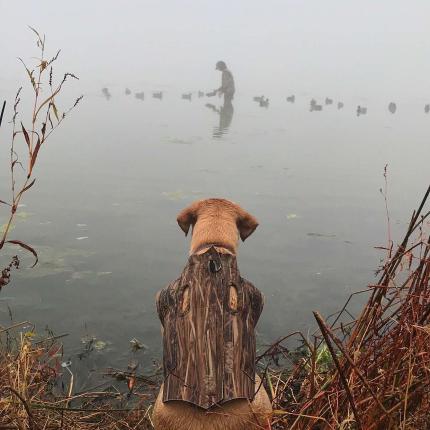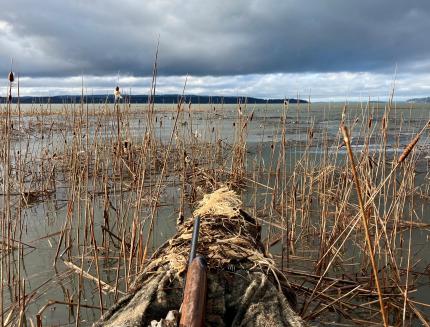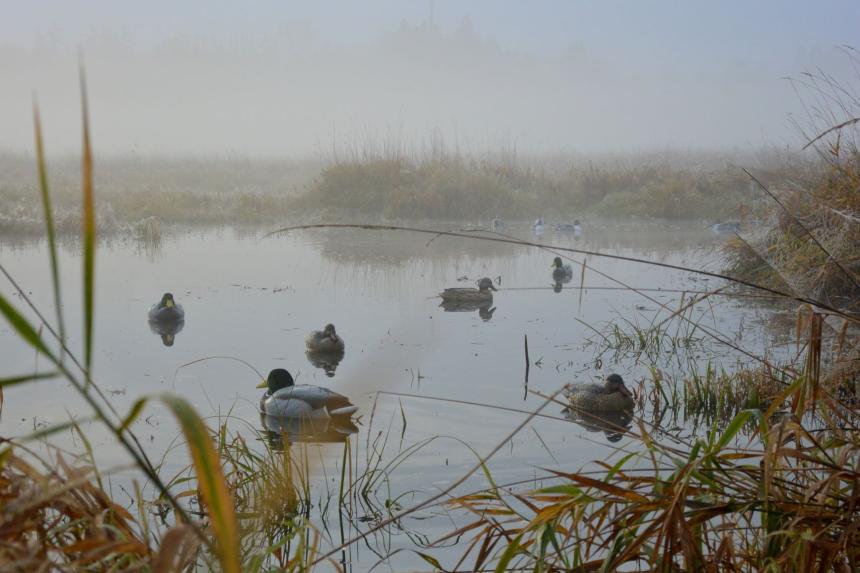
There are three basic methods of hunting waterfowl: hunting over decoys, jump shooting, and pass shooting.
Within those three methods, there are virtually limitless numbers of variations and combinations of the three, depending on the species you’re hunting and the minute-by-minute changes in circumstances that are an integral part of waterfowl hunting.
Hunting location and blinds
Much of waterfowl hunting comes down to location. This could be a pond, slough, field, small bay, or marine shoreline. Scouting before a hunt and learning where ducks or geese are flying, feeding and resting can yield huge benefits the following morning. This is also helpful for confirming safe and legal ways to access hunting grounds.
You also need to be well-concealed, so an outer layer of camouflage covering your body is typically a must. The outer layer should be both waterproof and warm. In many areas, especially marsh and tidelands, hip or chest waders are an essential piece of waterfowling gear, though boots may be sufficient for field hunting or pass shooting.
Once you have your outer wear, you’ll need to find a place to hide from the birds. Waterfowl hunters call this hiding place a blind. A blind can be ready-made or do it yourself, temporary and easily moved or, depending on where you’re hunting, permanent and simply cleaned up every season. Some use layout blinds, boats or kayaks equipped with blind material such as burlap, camouflage netting or raffia grass. Each hunter has their own preference, and you will want to try different blinds to see what works best for you. Breaking up the outline of your body, blind and/or boat with natural-looking material and colors is often the most important factor; more important than matching surrounding vegetation precisely or buying matching camo patterns.
Depending on your surroundings, you may be able to build a functional blind from available materials such as tree limbs, grass, cattails, or sagebrush. With any blind, be sure to complement it with whatever natural vegetation occurring at the hunting site. Hunters often bring folding stools or buckets to sit on, especially when shallow standing water is present. A dry bag or waterproof "blind bag" is also helpful for keeping shells, emergency clothing and other gear dry. Boat and kayak hunters should be sure to wear proper personal flotation devices (PFDs) and abide by state and federal boating laws.
Where you build or place a blind may well be as important as how it looks and how well it hides you. As a general rule, it’s best to be situated with the wind at your back, as ducks and geese prefer to land and take off into the wind. The predominate winds in the Pacific Northwest are typically out of the west and southwest.
Locating your blind within a crosswind (blowing right to left or left to right) is also a good option, as approaching waterfowl aren’t as likely to look beyond the decoys and be alarmed by something they see in or around the blind. Hunting from a blind with the wind in your face is the worst option because most ducks will come in from behind you, allowing for the shortest reaction time. Sometimes, however, you must make do with the conditions available and build the blind where it blends the best, regardless of wind direction.
Hunting over decoys
Hunting ducks and geese over decoys is in some ways a much more complicated endeavor than jump shooting or pass shooting, but when done right it can be the most productive strategy. The object is to wait for birds to come to you by enticing them to come closer than they might otherwise. This method also tends to bring waterfowl nearer to the shooter than pass or jump shooting.
Some hunters, especially those who hunt geese on open fields and those who hunts ducks on large bodies of water, may use dozens or even hundreds of decoys to help draw birds into shooting range. However, those starting out can still be effective with one or two dozen mallard decoys. Most ducks seem to recognize mallards, even fake mallards, and will feel safe landing among them. Even geese will sometimes be drawn in by mallard decoys. Green-winged teal are another effective addition to a decoy spread, especially for do-it-yourself walk-in, small boat or kayak hunters, as their small body size makes teal decoys especially portable. Some successful Pacific Northwest duck hunters also like to add a small number of Northern shoveler, pintail, wigeon or Canada goose decoys as visible accents on the edge of a spread of mallard decoys.
If your decoys look real and are placed where ducks may want to land, the number of decoys does not matter as much. This is especially true later in season when waterfowl flocks may become "decoy shy" due to hunting pressure.
Your number one priority with decoys is making sure they are visible from the air, so place them out in the open where they can be seen from as far away as possible. A dozen decoys crowded two feet apart into a corner of a 50-acre field will most likely go unnoticed by passing birds, as will decoys lined up tight to the edge of a cattail patch or placed under overhanging trees and brush in a small pond.
There are a lot of opinions on the best way to lay out a spread of decoys, but there are some general rules on which most hunter agree. One of those rules is that there should be an open spot or hole among the decoys so there’s room for incoming birds to land or attempt to land. Placing decoys in a C or J formation, with the open side facing downwind, is one popular way to accomplish this. Some hunters place three or four clumps of two or three decoys each on either side of a blind, leaving a large area of open water in the middle straight out in front of the blind. Be careful not to place your decoys too far from your blind, as this may cause ducks to land out of effective and ethical shooting range.
Big water hunters gunning for sea ducks and other diving species may use 100 or more decoys, and many of them use parallel strings or a J pattern of decoy presentation. Unlike puddle duck hunters, whose decoys each have a separate anchor line and weight, big water duck hunters may string dozens on one line so it doesn’t take hours to deploy and retrieve the decoys at the start and end of the day.
If your blind is on slough, small stream or side channel off a river, try blocking the channel you’re hunting with decoys. Flights of ducks on the main river often turn into the smaller feeder sloughs and channels when they see the decoys. If the channel is cut off, they’ll often drop right in on the first pass. Place a few singles, pairs, or small groups of decoys downstream, along the edges of the channel, to create pinch points to funnel landing birds toward your blind.

Jump shooting
As the name implies, this hunting method involves walking, running, crawling, or, in some cases, paddling or rowing to within shooting range of birds on the water or on the ground and flushing, or jumping, them in the air. In other words, the hunter is stalking the birds rather than waiting for them.
The method of stalking is determined by the situation. Jump shooting puddle ducks along a weedy slough or series of small ponds may be a matter of sneaking quietly from one cattail patch to another and shooting at singles or pairs of birds that rise within shooting range.
Jump shooting a flock of 150 Canada geese on a recently harvested cord field, on the other hand, may require a 45 minute crawl through 100 yards of mud and cow manure – and lots of luck – to get close enough for a shot. If those geese wander too close to an open hillside and a hunter can get to the back side of the hill without being spotted, the best strategy may be to charge over the hill to shorten the shooting distance before the surprised birds are out of range. Kayak or jonboat hunters may also paddle or drift quietly and tight to the bends of a river, lake or slough, hoping to surprise birds within shooting range. Remember that it is illegal to shoot from a watercraft under motor power or motion that resulted from motor power.
As the scenarios above illustrate, successful jump shooting requires a certain amount of reconnaissance, strategy, and stealth. Scout the areas you plan to hunt, wear camouflaged clothing and a face mask or face paint, and move quietly. Always be looking and listening as far ahead as possible, use the wind, weather, and available cover to your advantage, and always assume there are birds behind the next clump of cattails or around the next bend in the stream.
Pass shooting
Rather than going to where birds are resting or feeding and rooting them out, pass shooters find a spot where they think ducks or geese will pass by within range, then wait for the birds to come to them. The key is to put yourself in the right place at the right time, or your pass shooting efforts could lead to some long and boring days.
Luckily for hunters, ducks and geese are creatures of habit, and they tend to follow the same routines from season to season. That includes using the same travel routes between nightly roosting areas and daily feeding areas. As a pass shooter, the primary challenge is to learn the location of those travel routes and find ambush points along the way. In some cases, the research has already been done, as there are well-known pass shooting spots scattered throughout some of Washington’s prime waterfowl hunting areas.
Those traditional pass shooting spots tend to be popular, and sometimes crowded, so you may want to search out a few of your own. Start by figuring out where birds feed, where they rest, and what the routes might be between those areas. In some cases, the feeding and roosting areas may be a short distance apart. In other cases, the travel route may cover 10 miles of rolling hills between a river and a distant corn or wheat field.
Locate a hill where waterfowl pass, a point they fly over, or a narrow valley they fly through on the way. On the more open east side of Washington, you may find a high point and scan the countryside for signs of low-flying birds in the distance, zeroing in on frequently used places. Heavy rain and wind can be helpful for pass shooters, as this frequently causes waterfowl to fly at lower elevations.
While jump shooters may kick up birds throughout an entire day, most of the action for pass shooters is going to occur early and late in the day. These are the times when ducks and geese are traveling between roosting areas and feeding areas. Being in position by the start of legal hunting hours and being out before sunset will give you the best chance for success. Make sure you aren’t taking long shots or shooting beyond the effective range of your shotgun and ammunition combination so you can drop birds within easy retrieval range. Pass shooters should also be considerate of nearby blinds or decoy hunters, and avoid shooting birds working their spreads.
Duck and goose calls
There’s a duck or goose call for virtually every species and hunting situation, but it is important to research selections before you buy and practice frequently after purchasing. Someone who knows how to use a duck or goose call can be successful in drawing birds into shooting range. A bad caller, on the other hand, can chase them off even faster.
Learn to use a duck or goose call before you take the field. Follow the manufacturer’s directions and attend a calling seminar at a local sporting goods store or hunting club. Online tutorials and audio files can also provide instruction on calling all species of waterfowl. Listening to birds on a roost or feeding area and imitating them is a good way to practice your calls, even if you are not hunting.
Three of the more important calls to learn are a basic quack, which signals happy, contended ducks and can help attract nearby waterfowl; the hail call or "highball", made primarily by hens when calling on passing flocks to join them; and the greeting call, a series of quacks used as encouragement when ducks are approaching or circling a decoy spread or landing area.
Even after you master the basics, use a call sparingly. Over-calling is more likely to chase birds away than under-calling. Here are several pointers (paraphrased) from Ducks Unlimited’s 10 tips for duck callers:
- As long as the ducks appear committed to coming in, stop calling.
- When targeting particular species, try to use calls intended for those species (in other words, don’t depend entirely on the standard mallard call).
- If two or more people are calling, one should be the leader while others fill in. Don’t compete with your own hunting partners. This is especially true with hail or greeting calls.
- If what you are doing isn’t working, make a change of some kind.
Good luck, be safe, and happy waterfowl hunting!
